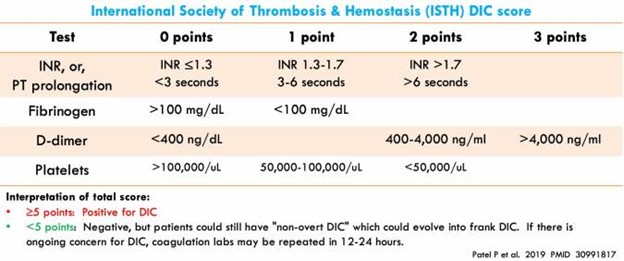Introduction
Introduction ( 5 Questions)
A nurse is reviewing the laboratory results of a client with pre-eclampsia.
Which of the following findings would indicate a risk of disseminated intravascular coagulation (DIC)?
Elevated platelet count is not a sign of DIC, but rather of normal pregnancy or other conditions that cause thrombocytosis. Platelets are blood cells that help form clots, and a high count means that there is an increased production or decreased destruction of platelets.
This indicates that the client has a risk of disseminated intravascular coagulation (DIC), which is a condition where the blood clots abnormally and causes bleeding in various organs. Fibrinogen is a protein that is essential for blood clotting, and a low level means that the clotting factors are being consumed faster than they can be produced.


Increased prothrombin time (PT) is not a specific sign of DIC, but rather of any condition that affects the extrinsic pathway of coagulation. PT measures how long it takes for the blood to clot by adding tissue factor, which activates factor VII. A prolonged PT means that there is a deficiency or dysfunction of factor VII or other factors in the common pathway (X, V, II, I).
Reduced partial thromboplastin time (PTT) is not a sign of DIC, but rather of hypercoagulable states or antiphospholipid syndrome. PTT measures how long it takes for the blood to clot by adding phospholipids and an activator, which activate factor XII.
A shortened PTT means that there is an increased activity or presence of factor XII or other factors in the intrinsic or common pathway.
Decreased fibrinogen level. This indicates that the client has a risk of disseminated intravascular coagulation (DIC), which is a condition where the blood clots abnormally and causes bleeding in various organs. Fibrinogen is a protein that is essential for blood clotting, and a low level means that the clotting factors are being consumed faster than they can be produced.
Choice A is wrong because elevated platelet count is not a sign of DIC, but rather of normal pregnancy or other conditions that cause thrombocytosis. Platelets are blood cells that help form clots, and a high count means that there is an increased production or decreased destruction of platelets.
Choice C is wrong because increased prothrombin time (PT) is not a specific sign of DIC, but rather of any condition that affects the extrinsic pathway of coagulation. PT measures how long it takes for the blood to clot by adding tissue factor, which activates factor VII. A prolonged PT means that there is a deficiency or dysfunction of factor VII or other factors in the common pathway (X, V, II, I).
Choice D is wrong because reduced partial thromboplastin time (PTT) is not a sign of DIC, but rather of hypercoagulable states or antiphospholipid syndrome. PTT measures how long it takes for the blood to clot by adding phospholipids and an activator, which activate factor XII. A shortened PTT means that there is an increased activity or presence of factor XII or other factors in the intrinsic or common pathway.
